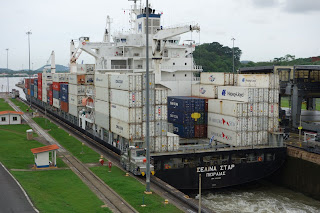 Who hasn't heard about the Panama canal? From what I remember, even at elementary school we are taught about this engineering monster finished early XXth century, which enabled economic growth of the US and Americas.
Who hasn't heard about the Panama canal? From what I remember, even at elementary school we are taught about this engineering monster finished early XXth century, which enabled economic growth of the US and Americas.As I learnt afterwards, it is possible to cross the canal with a small boat, and if you have time, you could even do it for free, pending you have few days/weeks to wait a sailing boat is looking for someone to pass by with.
I have done the simple visit though, i.e. going to the Miraflores locks, located 15 km from Panama city, and so the Pacific entrance of the canal. That day, again, the sun wasn't really of the party, at least when I was looking at the gates... so my pics miss light, but ok, they should still give fair views.
 |
| 1st view of the Miraflors lock |
Basically, I was looking at gates with 2 chambers, enabling the boats to go down or up, pending the direction, by 16.5m.
These are the 1st or last step to cross the 77 km isthmus of Panama, which usually takes 24h. Cost is said to be $100,000 for a loaded large vessel, wow!
 |
| Russian ship just after the gates, going to Pacific |
A Russian ship had just passed, and it was not that full and big.
Still, the view of the vessel's back trapped on the edges of the canal edges, started to be impressive. They really use the max of this 33.5m width!
Specific captains from the Canal's company do "drive" the boats crossing, I can understand why.
But then the big shit came. I mean, sorry, another vessel, fully loaded and really big. the CMA GGN King Fish". Oh My God.
 |
| Vessel arriving from the Gatun lake to |
Yes, when you see this vessel, 294m long and 32m, loaded with almost 1,000 containers, weighting close to 54,000 tons... being moved down in the pre-chamber before to cross the gates, and maneuvrated in this very thin water corridor... That is f%&§* impressive!!
Or may be that is the engineer part of me expressing itself, but after almost turning my feet back to the taxi after 10mn, I finally stayed there 2h looking at those Miraflores gates, and looking at a 3rd vessel passing through.
 |
| Gates view with vessel arriving Check the water flow created from the boat in the chamber! |
 |
| Slowly, the boat is lowered in the chamber |
 |
| Then cross the gates. Smile! ;) |
 |
| Train locomotives help to guide the boath through the gates |
 |
| The impressive vessel... so huge, about 80 containers per row, and I counted 12 rows!! |
After this time along the canal, a small museum gives insights on the construction and the role of the Canal. Interesting, as indeed a good part of what we consume everyday or electronics/clothes/food we buy has somehow probably transited by the canal, or at least some parts.
 |
| A pic of a frame showing well how the canal works |
 |
| Video view from a vessel's cabin |
 |
| Canal's business and routes around the world |
How the Canal works? (wiki)
If you are interested, check the following link!
http://en.wikipedia.org/wiki/Panama_Canal
The Panama Canal (Spanish: Canal de Panamá) is a 48-mile (77.1 km) ship canal in Panama that connects the Atlantic Ocean (via the Caribbean Sea) to the Pacific Ocean. The canal cuts across the Isthmus of Panama and is a key conduit for international maritime trade. There are locks at each end to lift ships up to Gatun Lake (85 feet (26 m) above sea-level). Gatun Lake was created to reduce the amount of work required for the canal. The current locks are 110 feet (33.5 m) wide. A third, wider lane of locks is being built.

No comments:
Post a Comment